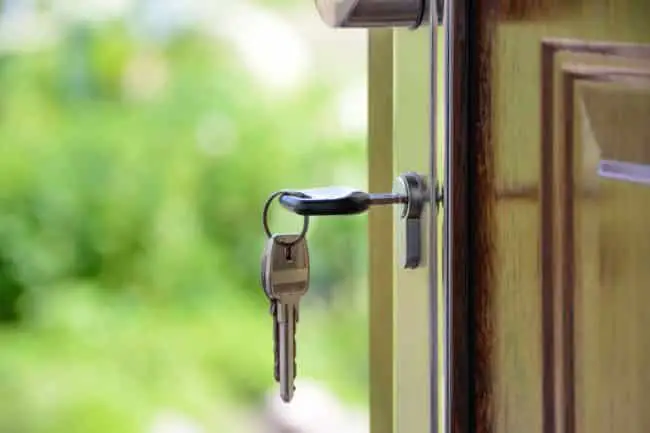Real estate is a very attractive asset class. However, it doesn’t come without risks. If you are going to buy a home or become a landlord, consider these real estate risks before you make your big decision.
Top 13 Real Estate Risks to Understand Before Investing
Investing in real estate is an ideal passive income strategy and a way to diversify your portfolio. However, there are so many real estate risks that every investor must know. It’s important to understand how the risk of real estate investment occurs and ways of mitigating it.
There is no doubt that the majority of people are turning to real estate investments since they consider them safer and more secure than many other investment opportunities.
Adding an extra stream of income is a smart move that can boost your finances and guarantee future financial stability. I’ve been investing in the stock market and real estate to continually build wealth. I even wrote a book about it called Dividend Investing Your Way to Financial Freedom.
You can download a sample of the book if you are interested in learning more.
Thus, real estate investing is something that every person should have in their asset allocation to ensure you can increase your income and build wealth at the same time. Real estate investing has many similar variables to investing in sound businesses for income and capital appreciation.
My goal is to live mortgage free by using a combination of investing and real estate income to accelerate paydown of my mortgage.
I track all of my cash flow for completely free using Personal Capital. This is a great way to follow your net worth and income over time… Completely automated and hassle-free.
Why real estate investment risks matter
Real estate investing seems like a straightforward exercise. However, there are many complexities that are completely outside of your control. Before making a real estate investment, you have to research and consider these risks before making your big investment.
Otherwise, you could end up losing money or stuck with a stranded asset that is producing negative cash flow. That means you have to put up more money just to keep it afloat and operating! Continue learning about real estate investing by reading these books about real estate.
How to Conduct Real Estate Risk Analysis
These real estate investment risks are important in a number of considerations beyond just buying your own property and renting it out. You need to understand the risks of real estate in the following situations:
- Investing in public or private Real Estate Investment Trusts (REITs), these can be hotels, senior living, hospitals and more
- Real estate crowdfunding
- Purchasing your own home and renting it on Airbnb
- Investing in an income property and finding a long-term renter
- Investing in commercial real estate
The list goes on… A number of these considerations for investing in real estate related to other investments too. Your real estate risk analysis should include all of the following below.
Some of these will be covered in your home appraisal, but you should always conduct your own due diligence before investing. Your due diligence and real estate risk analysis should include the following:
- Site visit of the property
- Comparable property sales on a $ per square foot basis
- Site visit of the market and city
- Economic analysis of the region through job statistics, major employers, affordability and market forecasts
Let’s get into the risks associated with real estate investing.
List of Real Estate Risks to Consider Before Investing
To get it right in this ever-changing industry, one cannot evade the need to understand the real estate risks to take precautionary measures. In this article, we will focus on the 13 top real estate risks to realize before making that bold investment move.
Market Risk
The market trends and economic conditions vary every day. Real estate industry is of no exemption. There occur changes and forces in the sector, and so, an investor should do in-depth research as well as understand the prevailing market trends before they make an investment decision.
If the market conditions are right, it results in high tenant occupancy, and the opposite also applies. All factors that affect the demand and supply of the real estate market will have a significant impact on your investment value.
You should have a good estimation of the market condition before you invest to understand future prospects. Consider doing your assessment before your home appraisal in our checklist. From there, read the home appraisal report to understand the appraiser’s viewpoint on the real estate market for that particular location.
Physical Asset Risk
The physical asset risk is a kind of risk that emerges when unprecedented costs occur due to the physical condition of the property. When a property ages, there is an excellent potential for unpredictable issues that develop including wear and tear. It, therefore, calls for such things as costly equipment repairs and replacements as well as renovations.
A prudent investor ought to consider all this and take a physical assessment before investing in an asset. They should seek a professional opinion on the condition of the property to avoid eminent losses. An investor should perform due diligence to avoid buying a property that has unseen structural problems which may later cause expensive repairs and maintenance.
You may want to consider negotiating in a home warranty in your purchase of the home, so you can reduce capital expenditures during your first few years of ownership.
Investor/Sponsor Risk
Another kind of real estate investment risk is the investor also called sponsor risk. It is brought about by the inability of the developer executing the business plan as well as not delivering the expected results to the stakeholders. It is divided into two categories namely:
- Asset Management Risk: It the risk that depends solely on the asset manager’s expertise since he is the one who has been entrusted with the responsibility of implementing the business plan to ensure successful results.
- Property Management Risk: some assets such as multifamily, senior housing, and hospitality, require distinct customer service as a vital part of effecting a business plan thus highly rely on property management. Therefore, exceptional property management is paramount in these cases to ensure daily onsite operations run effectively.
Foreclosure Risk
Another real estate risk occurs when an investor fails to honor their obligation of paying their mortgage installments. If an investor defaults to pay for some few months, the property faces the risk of foreclosure or may lose the property to the bank.
A foreclosure affects you negatively and limits your chances of acquiring loan approvals from banks.
Over-leveraging
If a property losses a significant number of tenants, the debt coverage service ratio may drop to below 1.0 due to the fall in the property’s income. The resulting fall may place the property on the risk of not fulfilling on its mortgage.
If a property is leveraged above 80% of the value, which in most typical cases should be between 0-80 percent, then the assets can be termed as overleveraged.
Keep in mind that you are on the lowest part of the capital stack as an equity investor.
Debt Maturity Risk
It is a risk that occurs as a result of an asset’s debt maturing at a time when its operating capital is compromised or during a market downturn.
The project may then fail to get credit on the same amount of the unpaid debt thus making the project to fall into the risk of defaulting on its mortgage.
It happens since the investors may fail to raise the necessary capital to finance the project.
Liquidity Risk
Since real estate assets are illiquid, it means that an investor is not able to readily convert them to liquid cash. The process of selling an asset is also complex and slow thus if, in need of quick money, you cannot rely on an asset to sort you out.
Selling a property at a rush may also result in losses since you might never get the desired market value for it.
Tenant Risk
Tenant risks can be divided into two categories namely; rent power risk and rollover risk:
- Rent Power Risk – it’s a kind of risk that depends on the paying and staying capabilities of the tenants. When looking at this risk, you need to understand the financial abilities of the tenants. What is the creditworthiness of the tenants in a particular property, their stability and also the number of tenants? Whether the tenants have staying power or whether their businesses would fail and force them to close or default on the lease are paramount issues that you should consider. The large tenants like Google or Wal-Mart are deemed to be less risky and thus are desirable unlike the small and individual tenants
- Rollover Risk – it refers to the term remaining on leases of a certain property. It affects all types of tenancy whether single or multi-tenant properties. An investor should understand the type of lease on the property they are targeting to invest in as they will pay a premium on the lease’s value which may turn to a loss if the tenant default on the lease.
The tenant risk for residential and commercial are very different. For example, investing in a hotel has diversified short-term tenant risk whereas a standalone commercial site has single tenant risk but longer-term contracts.
Negative Cash Flow Risk
Cash flow in real estate investment refers to the net profit the investor gets after taxes, mortgage, and other expenses. Negative cash flow would occur when the taxes, expenses, and mortgage payments are greater than the total income thus creating a potential loss of money for the investor.
One should properly calculate the income and expenses and income out of the property before investing.
Leasing/Vacancy Risk
It occurs when an investor invests in a property where a vacancy exists, anticipating to lease up space but the lease up doesn’t happen, or it takes a longer time than expected to get a tenant. It is crucial to moderate the lease-up risk by planning for proper amounts of resources and time in a pro forma when considering lease up situations. Ensure that you price in the risk for leasing when you value the property with a cap rate.
Here’s how to calculate a cap rate for your income property.
Construction Risk
When undertaking major construction developments whether new or renovations, the project may face various risks. The project may incur cost overruns, the project taking longer to complete than anticipated, exposure of physical weaknesses in the property that were previously unseen and more.
All these may pose various risks including physical asset risk and leasing risks thus the need to properly evaluate the property first.
Geographic Risk
The value an asset is highly influenced by the geographical location of the property, the population size, demographics and job growth among other factors. Properties in areas with high population or high pool of tenants such as New York, L.A., Chicago or San Francisco are known as the primary markets and are desirable since it insulates against market dips.
On the other hand, markets with shallow or low population base are considered riskier as they are susceptible to the market changes.
Entitlement Risk
Any new project developments entail complex and lengthy processes such as obtaining a municipal approval for new construction. The whole process is what is referred to as the entitlement process and poses an entitlement risk before you acquire the permits to construct.
Avoid this to stay up to date with your realtor on market terms.
Conclusion on Real Estate Risks
There are plenty of risks for investing in real estate, both on the new construction and operating side of the equation. Become a savvy investor by thinking through every piece of the pie with your investment returns.
You can mitigate the above risks by funding a basket of real estate crowdfunding opportunities through CrowdStreet. Read more about it in our CrowdStreet Review.
There are other ways to start investing besides real estate. Here is a guide to help you start investing easy.
Understand the financial ratios of your investments to continue with an effective strategy. Ratio analysis can tell you more about a property’s performance than just the financial statements alone.
I hope this list of top 13 real estate risks will help you avoid pitfalls when making real estate investments. It is crucial for any investor to perform thorough research before making an investment decision to minimize the possibility of incurring losses and to guarantee a positive Return on Investment (ROI).
What are your most feared real estate risks? Please let us know in the comments below. I’d love to hear from you.
Other How to Invest Money Resources
- How to invest money to ensure success, including investment tips to consider
- Best robo-advisors compared to help you automate your investing
- How to build a dividend portfolio from scratch
Subscribe to the Millionaire Mob early retirement blog newsletter to find the best travel hacking tips, dividend growth investing, passive income ideas and more. Achieve the financially free lifestyle you’ve always wanted.








No Comment